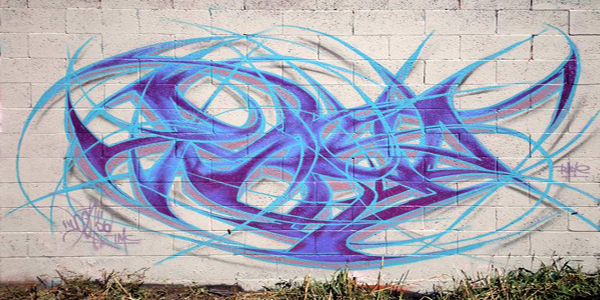
 |
The great challenge of graffiti is to create a design framework for the letters in one's name which is so personally tailored that it allows for the expression of attitudes, opinions, emotions, and soul. Since the set of letters in the name that one paints do not change, the way they are painted is what conveys meaning. For instance, I will always paint an S, an O, an N, an I, and a K, in that order, but in each painting I have different messages which I hope to convey. In order for any personal meaning to show through in my paintings, I must paint them with a style that is every bit as personal. If I paint in a way that is truly my own, I will have a voice that is truly my own. With a voice that is entirely personal, I can convey messages which are every bit as personal without losing any of their meaning.
Style alone will not impart serious meaning upon a graffiti piece, but it is the only tool with which meaning can be effectively conveyed via lettering. Style is how one presents one's ideas. It is the way one creates, the framework and the foundation for all of one's work. Beyond that, it is the one true voice that exists within each of us, the voice that has so often been buried by years of acting like other people. The framework of style is the framework of yourself. Style, loosely, is the artistic equivalent of enlightenment. It means fully knowing one's self.
Technique is something which can be taught, but style is something which must be discovered within one's self. Technique is universal, style is personal. Because technique and style are separate to some extent,this often creates confusion as to which to learn first. Technique is undoubtedly easier to learn, and will be developed naturally if one paints a great deal and constantly tries new ways of painting. Many graffiti writers make the mistake of learning technique first, in order to make their pieces pretty, and think that style can somehow wait until they have the means to express it in a way that is technically pretty. This is a grave mistake. The first thing any writer must do is develop their own style, for without it they will create shallow artwork, regardless of how technically advanced it is.
Of course, everyone copies style at the beginning, and that's okay. There are "basics" to learn in graffiti, just like any other art form. Many great graffiti writers got their start by basing their work on the style of their local heroes, but then, initial lessons learned, they moved on to establish their own. It is indeed a beautiful sight to see individual writers make leaps and bounds as they develop their own voice and build on the work of their elders. However, what is infuriating is when graffiti writers young or old think that their success can be achieved by creating a collage of other writers' styles. These people only fool the ignorant. A classic trick of the style-less writer is to pick one of their favorite graffiti heroes and shape into their own name the letters that their hero has worked so tirelessly to perfect in an individual style. This is degrading on many levels. It degrades the copier for obvious reasons. It degrades the copied as well. Copying someone else's style objectifies them and renders them artistic commodities who have lost control of their work. This is not something which any true artist would want for their heroes.
- Credits:
- https://www.graffiti.org/